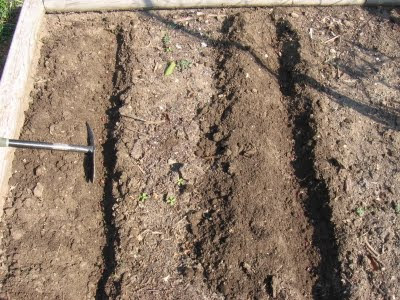This is the former onion bed, now mostly empty. I planted 1/2 runner beans to replace the cucumbers that should be all over the trellis by now. I haven’t decided if I’ll replant the rest of the bed yet. There’s also an okra plant and oregano in the bed.
I was thinking that I should plant some nitrogen-fixing fall cover crop for the spaces that won’t be planted anymore this year. Too late this year - I never ordered any. I plant patches of snap beans about every two to three weeks in open bed spaces. I think of them as something like a cover crop since beans are legumes, so they should improve fertility. This patch of Provider beans is in the formerly known as brassica bed. They are ready to produce very soon. In the upper corner is a Gypsy broccoli with the last head of broccoli of the year. The cauliflower plants that looked great a few weeks ago have really suffered in the heat wave. I don't know if they will make heads.
The patch of Dragon Langerie wax beans that were planted after spinach and lettuce were finished. They weren’t producing much at this point and the foliage showed a lot of bug and disease damage. Time for them to go. I cut them off at the base so the roots could decompose in the soil. The stems and leaves went in the compost bin. There's still some swiss chard in this bed, also some carrot and herbs, cilantro that went to seed. I found that I don't really like chard, but it looks nice, all those multicolored stems, so it'll probably go from here straight to the compost bin. That bed has done enough work for the year, it deserves a rest.
The butternut is starting to grow again and is setting more squash. In June it produced six nice sized butternuts that are flesh colored now. After that initial fruitset it stopped growing. Don’t really know why, unless the wilt that got the other cucurbits stressed this plant but did not kill it. The removal of the runner bean that shared the trellis may have helped the squash along. Now it’s putting out some new vines and a lot of female flowers. I’m hoping it will fill the space left by the defunct Acorn squash.
Two years ago the same butternut variety showed a similar growth pattern, resuming production in August. After Labor Day I decided to remove any new squash that set, believing they couldn’t mature before the first frost. That plant produced about twenty- five nice butternuts that lasted all winter, and I probably threw away as many immature fruits. This year I’ll let the plant set fruit a little later into the fall. I've noticed that the leaves on the trellis get less pressure from squash bugs.
The Red Pontiac potatoes in the cages have lost most of their foliage. It looked like it was time to remove the cages and dig up the potatoes. Then I noticed that some new foliage was emerging along the stems, so I left them for now. Maybe the potatoes will get a second wind, like the squash, and put out some new foliage. It’s worth waiting a little longer to see if I can get more production. Anyone who thinks that home-grown potatoes are no different than store bought needs to raise a few potatoes. They are way way better, and keep longer.
The parsnips quietly process sunlight and CO2 and feed sugars into the roots, never asking for much other than some space of their own. Once established their deep roots mean little demand for water or fertilizer. I staked the four corners of the patch and ran a line of string around it to contain the foliage in the bed. Some of the foliage is showing some stress from the heat and maybe some microbial pressure, but no bug problems at all so far. I removed the dead and yellowed foliage this morning. Parsnip is like the black box system that can’t be viewed until the process is complete. You plant it in April and don’t know what you will get until winter. But I think this patch is going to produce a lot of nice size sweet parsnips.
That’s it – a lot of open spaces right now. But the tomatoes, peppers and eggplant are really producing. No complaints.







No comments:
Post a Comment